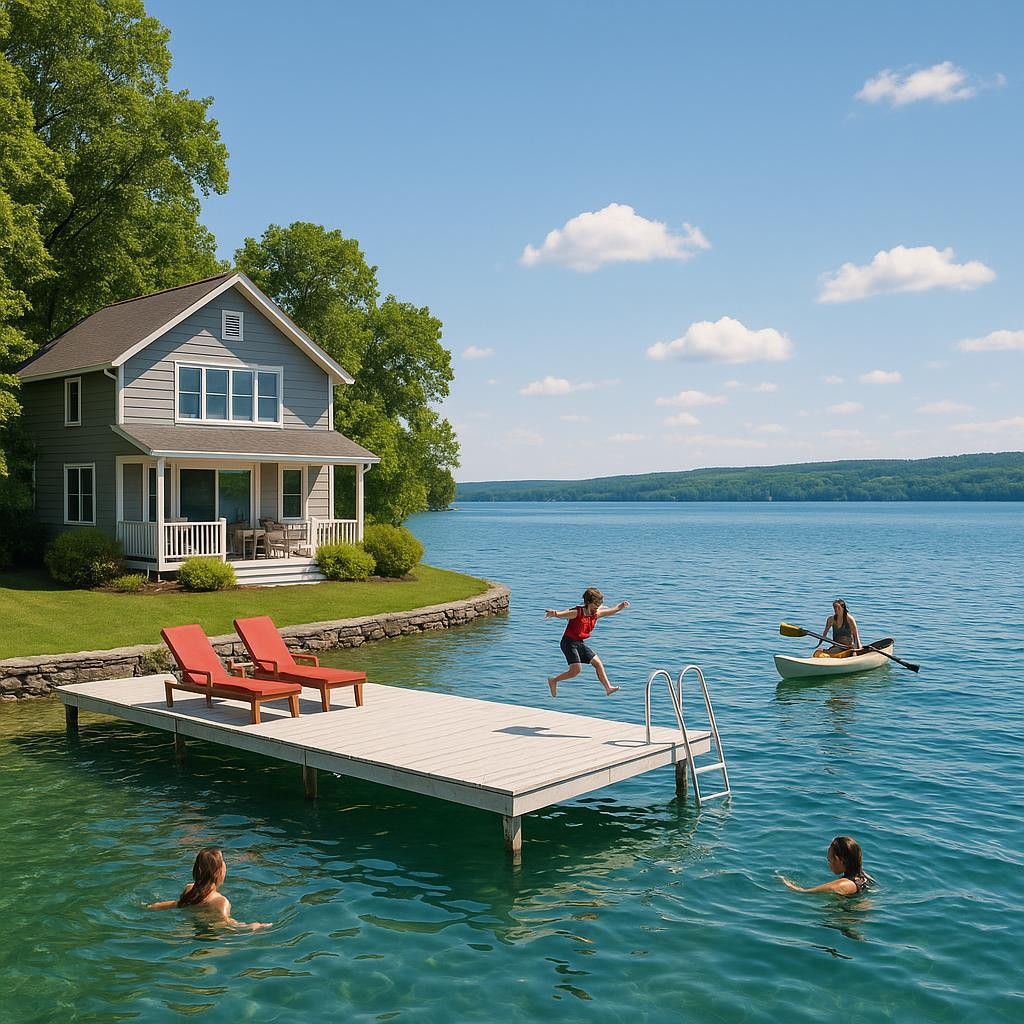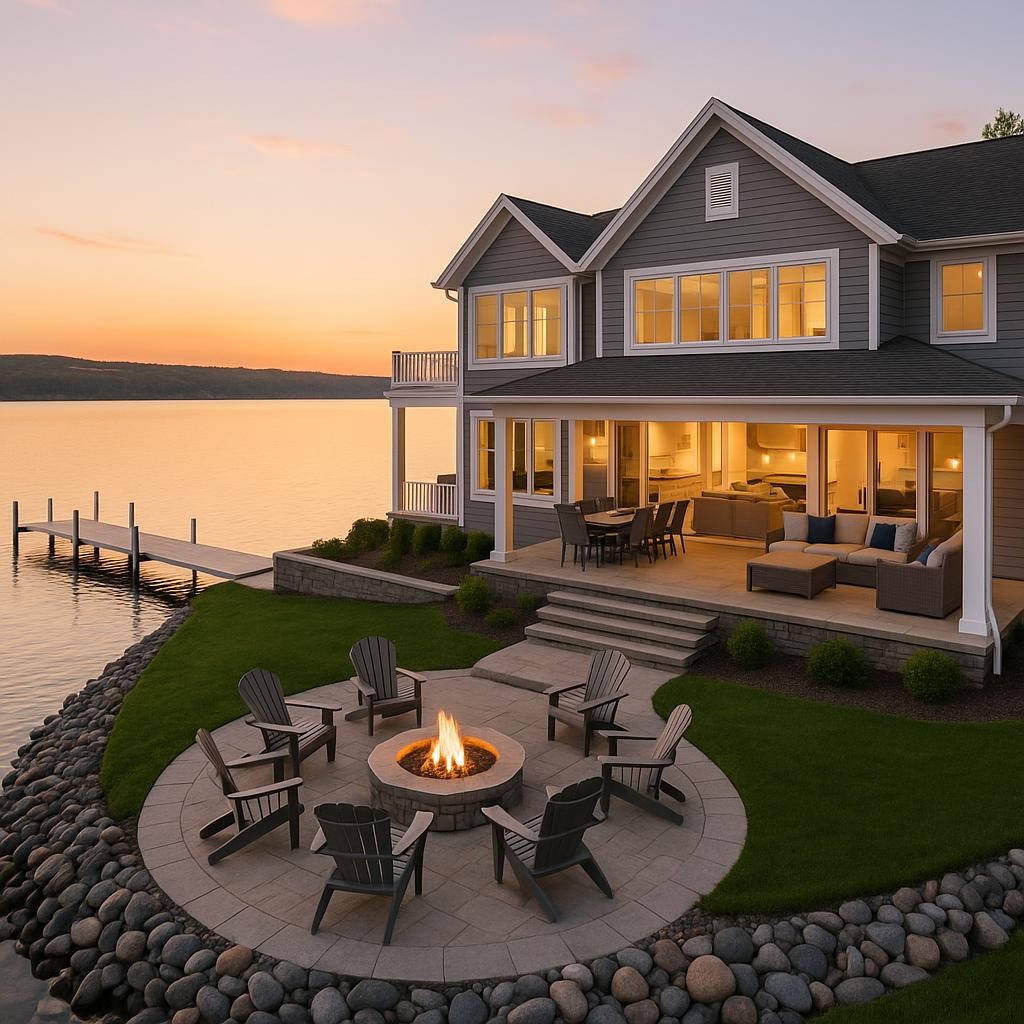Your Complete Guide to Finger Lakes Vacation Rentals: Why Early Booking Secures the Best Lakefront Properties

The Finger Lakes region of New York represents one of the most sought-after vacation rental markets in the Northeast, with lakefront properties commanding premium rates and exceptional occupancy levels. Recent market data reveals that vacation rental demand has grown 7% year-over-year while supply increased only 4.7%, creating a tightening market where early booking strategies become crucial for success.
Lakefront vacation rentals in the Finger Lakes consistently outperform other property types, benefiting from the region's unique combination of natural beauty, world-class wineries, and year-round recreational activities. With average booking lead times extending to 47 days for comparable markets and peak summer months booking up to 62 days in advance, property owners who understand early reservation dynamics gain significant competitive advantages.
This comprehensive guide explores proven strategies for securing the best Finger Lakes vacation rental opportunities, maximizing occupancy rates, and capitalizing on the region's robust tourism economy through strategic early booking approaches.
The Finger Lakes Vacation Rental Market: A High-Demand Investment Opportunity
The Finger Lakes vacation rental market has emerged as a premier investment destination, driven by the region's unique appeal and consistently strong tourism fundamentals. With eleven pristine lakes stretching across central New York, the area attracts millions of visitors annually seeking authentic experiences combining natural beauty, recreational activities, and world-renowned wine tourism.
Current market indicators reveal exceptional strength in the vacation rental sector. National trends show demand growing at 7% annually while supply increases lag at just 4.7%, creating favorable conditions for property owners. The Finger Lakes benefits disproportionately from this dynamic due to limited lakefront development opportunities and strict zoning regulations that constrain new inventory.
Lakefront properties represent the market's crown jewels, consistently achieving occupancy rates 15-20% higher than comparable inland rentals. These premium locations command daily rates often exceeding $400-600 during peak seasons, with annual revenue potential reaching $75,000-125,000 for well-managed properties.
The region's diverse tourism appeal creates multiple revenue seasons. Summer brings families for swimming, boating, and outdoor adventures. Fall attracts visitors for spectacular foliage and harvest festivals. Winter offers ice fishing and cozy retreat experiences, while spring appeals to wine enthusiasts exploring the emerging growing season.
Investment fundamentals remain strong with limited new development opportunities constraining supply growth. Regional tourism boards report steady visitor growth, supported by improving infrastructure and expanded marketing efforts. The proximity to major metropolitan areas including Rochester, Syracuse, and Buffalo provides a reliable guest base within 2-3 hours' drive.
For vacation rental investors, the Finger Lakes market offers exceptional stability, growth potential, and the operational advantages of a well-established tourism infrastructure supporting successful property management.
Peak Season Dynamics: Why Summer and Fall Drive Premium Lakefront Bookings
Understanding seasonal booking patterns is crucial for maximizing vacation rental performance in the Finger Lakes region. Research indicates two distinct peak periods that drive the majority of annual revenue: summer (June-August) and fall (mid-September through mid-October), each offering unique opportunities for property owners.
Summer represents the primary revenue season, with families and groups seeking lakefront access for swimming, boating, and water sports. During these months, well-positioned lakefront vacation rentals achieve occupancy rates consistently exceeding 85-90%. The combination of warm weather, extended daylight hours, and school vacation schedules creates sustained demand that allows premium pricing strategies.

Recent tourism data reveals that fall foliage season generates comparable revenue to summer months, with peak bookings occurring during the second and third weeks of October. This period commands premium rates as visitors seek front-row seats to spectacular autumn colors reflected across the lakes' surfaces.
The shoulder seasons present strategic opportunities for revenue optimization. Early fall (September) attracts guests seeking mild weather with fewer crowds, while late fall offers value-conscious travelers willing to accept cooler temperatures for reduced rates. Winter bookings, while lower in volume, can provide steady income from guests seeking peaceful retreats and winter recreational activities.
Booking lead times vary significantly by season. Summer reservations typically begin in February-March, with prime July weeks booking 60-90 days in advance. Fall foliage periods often book even earlier, with repeat guests securing their preferred properties up to 12 months ahead.
Property owners who align their marketing strategies with these seasonal patterns, adjusting pricing and availability policies accordingly, consistently outperform competitors. Understanding these dynamics enables proactive inventory management and strategic pricing decisions that maximize both occupancy and revenue throughout the year.
Early Booking Advantages: Securing Prime Properties Before Competition
Early booking strategies provide vacation rental owners with significant competitive advantages in the high-demand Finger Lakes market. Property owners who implement proactive reservation systems consistently achieve higher occupancy rates and command premium pricing compared to those relying on last-minute bookings.
The primary advantage of early reservations lies in inventory control. With limited lakefront properties available, guests increasingly book 6-12 months in advance for peak seasons. Property owners who open their calendars early and implement strategic pricing capture this early-booking segment, which typically represents 40-60% of annual revenue.
Guest behavior analysis reveals that early bookers often represent higher-value customers. These guests typically stay longer (average 4-6 nights versus 2-3 for last-minute bookings), spend more on local activities, and demonstrate higher satisfaction rates. They're also more likely to become repeat customers, reducing marketing costs over time.
Market research indicates that while last-minute bookings have increased nationally to 26% of reservations, premium destinations like the Finger Lakes maintain different patterns. High-demand lakefront properties continue to book well in advance due to limited alternatives and unique location advantages.
Revenue optimization through early booking strategies includes implementing dynamic pricing that rewards advance reservations. Offering 10-15% discounts for bookings made 90+ days in advance often increases total revenue by securing guaranteed occupancy and enabling better operational planning.
Property owners should establish booking timelines aligned with guest behavior: opening summer calendars in January, fall foliage availability in spring, and holiday periods immediately after prior year's season ends. This proactive approach ensures maximum exposure during peak booking periods and positions properties ahead of competition.
Lakefront Property Premiums: Understanding the Value Proposition
Lakefront vacation rentals in the Finger Lakes command substantial premiums over inland properties, with strategic positioning and amenities justifying rates often 50-100% higher than comparable non-waterfront accommodations. Understanding this value proposition enables property owners to optimize pricing strategies and marketing approaches.

The premium pricing structure reflects genuine scarcity. With over 11 lakes and limited shoreline development, true lakefront properties represent less than 5% of available vacation rentals. This scarcity, combined with zoning restrictions preventing new construction, creates sustainable competitive advantages for existing lakefront owners.
Guest experience factors driving premium valuations include direct water access, unobstructed lake views, private docking facilities, and exclusive use of waterfront amenities. Properties offering swimming access, kayak storage, fire pits with lake views, and outdoor entertaining spaces consistently achieve the highest rates and occupancy levels.
Market data analysis reveals lakefront properties achieve average daily rates (ADR) of $400-600 during peak seasons, compared to $200-350 for inland properties with similar bedroom counts. Annual revenue potential for well-managed lakefront rentals ranges from $75,000-125,000, significantly exceeding inland property performance.
The operational advantages of lakefront properties include reduced marketing costs due to higher demand, improved guest retention rates, and enhanced property appreciation over time. Investment fundamentals remain strong with waterfront real estate historically outperforming broader market indices.
Competitive positioning requires emphasizing unique lakefront features in marketing materials, professional photography showcasing water views and amenities, and premium service levels matching elevated pricing. Property owners who properly leverage their lakefront advantages while maintaining exceptional guest experiences consistently achieve top-tier market performance.
Strategic Timing: When to Book for Maximum ROI and Guest Satisfaction
Strategic booking timing optimization requires understanding both guest behavior patterns and market dynamics specific to the Finger Lakes vacation rental ecosystem. Property owners who master these timing elements consistently achieve superior financial performance and guest satisfaction scores.
Calendar management strategies should align with documented booking patterns. Summer properties should open reservations in January, capturing early planners while implementing dynamic pricing that rewards advance bookings. Fall foliage availability should launch in April-May, positioning properties ahead of competitors for this high-value season.
Pricing optimization through strategic timing includes implementing early-bird discounts of 10-15% for bookings made 90+ days in advance. This strategy guarantees occupancy while enabling better operational planning. Conversely, last-minute premium pricing (30-day window) can capture urgent demand at elevated rates.
Research indicates that comparable vacation markets show average booking lead times of 47 days, with peak periods extending to 62 days. Finger Lakes properties should establish booking windows reflecting these patterns while considering seasonal variations.
Guest communication timing proves equally crucial. Automated pre-arrival sequences beginning 30 days before check-in enhance guest experience while reducing operational burden. Post-booking engagement maintains momentum and encourages positive reviews, with follow-up communications scheduled at strategic intervals.
Competitive advantage emerges from understanding that different guest segments book at different times. Business travelers and couples often book 30-60 days ahead, while families with children typically plan 90-120 days in advance. Tailoring marketing messages and availability strategies to these patterns improves conversion rates.
Property owners should establish booking calendars that balance guaranteed early revenue with flexibility for premium last-minute demand. This balanced approach, combined with strategic pricing and guest communication, maximizes both revenue potential and operational efficiency throughout the year.
Market Intelligence: Leveraging Booking Trends for Competitive Advantage
Market intelligence utilization enables vacation rental owners to make data-driven decisions that consistently outperform competitors in the dynamic Finger Lakes market. Property owners who systematically analyze booking trends, guest behavior, and competitive positioning achieve superior long-term results.
Competitive analysis should focus on comparable lakefront properties within your specific lake region. Monitor pricing strategies, availability patterns, and guest review themes to identify market gaps and positioning opportunities. Properties that differentiate through unique amenities or superior service often command 20-30% premiums over similar accommodations.
Guest data analysis reveals valuable insights for optimization. Track booking lead times, length of stay patterns, seasonal preferences, and guest demographics to refine marketing strategies. Properties serving primarily families require different amenities and communication approaches than those targeting couples or business travelers.
Revenue management through market intelligence includes implementing dynamic pricing based on local events, weather forecasts, and competitor availability. Tourism patterns show that successful properties adjust rates based on real-time market conditions rather than static seasonal pricing.
Technology integration enables automated market monitoring and competitive intelligence gathering. Property management systems with built-in analytics provide insights into optimal pricing, inventory management, and guest communication timing. These tools eliminate guesswork while enabling proactive strategy adjustments.
Performance benchmarking against market averages helps identify improvement opportunities. Track metrics including occupancy rates, average daily rates, guest satisfaction scores, and repeat booking percentages. Properties consistently achieving top-quartile performance typically implement systematic approaches to market intelligence rather than relying on intuition.
Property owners who treat market intelligence as a strategic asset, rather than an operational afterthought, position themselves for sustained success in the competitive Finger Lakes vacation rental market.
Conclusion
The Finger Lakes vacation rental market presents exceptional opportunities for property owners who understand and implement strategic early booking approaches. With demand outpacing supply growth and lakefront properties commanding substantial premiums, success requires proactive planning and data-driven decision making.
Key strategies for maximizing performance include opening booking calendars early, implementing dynamic pricing that rewards advance reservations, and positioning properties to capture both summer and fall peak seasons. Property owners who leverage market intelligence while maintaining exceptional guest experiences consistently achieve top-tier financial performance.
The competitive advantages of early booking extend beyond immediate revenue benefits. Strategic timing enables better operational planning, attracts higher-value guests, and positions properties ahead of competitors during peak booking periods.
For vacation rental owners seeking to maximize their Finger Lakes investment, implementing comprehensive early booking strategies represents one of the most effective approaches to achieving sustained success in this premium market segment.
